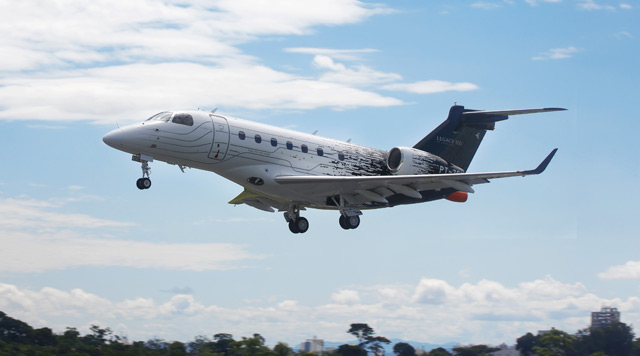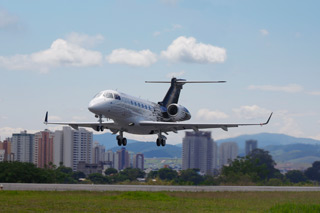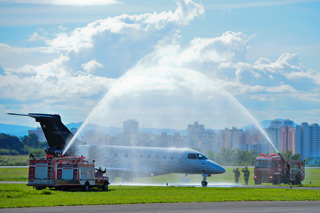
The Legacy 500 made its first flight Nov. 27, using the first full fly-by-wire flight control system for the midsize business jet market. Photos courtesy Embraer.
Embraer Executive Jets’ 3,000-nautical-mile Legacy 500 made its first flight Nov. 27, the company announced.
The Legacy 500 is the first midsize business jet to use a full fly-by-wire flight control system and feature a six-foot, stand-up cabin with a flat floor. It marks Embraer’s third clean-sheet business jet design since the company set its sights in 2005 on becoming a major player in the market.
“This is the aircraft that will move us from industry player to industry leader,” said Embraer Executive Jets President Ernest Edwards in a media release. “The Legacy 500 breaks through the traditional midsize jet envelope to offer something that has never been done before. It is hard to overstate the importance of fly-by-wire technology. Fly-by-wire does for business aviation what GPS has done for navigation. It will empower more precision, efficiency, safety and comfort every time the aircraft flies.” 
Software issues with the fly-by-wire system delayed the first flight from an earlier projection of the second half of 2011, but Edwards dismissed the problems as “just a bad dream now” in a media briefing in October, when the company showed off its newly painted prototype to reporters at its São José dos Campos, Brazil, headquarters. Now that the technology is proven, Embraer plans to employ it in the Legacy 450, a “mid-light” jet expected to fly in the second half of 2013, and the military transport KC-390, followed by Embraer’s commercial models.
The fly-by-wire system, which uses onboard computers instead of cables and pulleys to command the flight control surfaces, offers envelope protection based on “hard” and “soft” limits. Pilots may operate outside the soft limits of the normal flight envelope by applying continuous control deflection, but the system protects the airplane from overstress with hard limits.
Test pilots Mozart Louzada and Eduardo Camelier, along with flight test engineers Gustavo Paixão and Alexandre Figueiredo, flew the aircraft for an hour and 45 minutes, evaluating handling and performance characteristics and assessing aircraft systems, including landing gear retraction. Embraer said they were able to cover a significant flight envelope on the maiden flight because the company had conducted extensive simulation and ground testing. Louzada said in the media release that the flight went precisely according to plan.
 The Legacy 500 and 450, for which the company is pursuing a common type rating, will fill the gap in Embraer’s business jet product line between the Phenom 100 and 300 and the Legacy 600 and 650. The company has followed an aggressive schedule of bringing new products to market since it set out a vision in 2005 to become a major player in the business jet industry in the next 10 years. At that time, the company had only one business jet, based on the platform of the ERJ-135 regional jet. Deliveries of the Legacy 500 are expected to begin in 2014. The entry into service of the Legacy 450 a year later will mark the company’s fourth clean-sheet design, Embraer said.
The Legacy 500 and 450, for which the company is pursuing a common type rating, will fill the gap in Embraer’s business jet product line between the Phenom 100 and 300 and the Legacy 600 and 650. The company has followed an aggressive schedule of bringing new products to market since it set out a vision in 2005 to become a major player in the business jet industry in the next 10 years. At that time, the company had only one business jet, based on the platform of the ERJ-135 regional jet. Deliveries of the Legacy 500 are expected to begin in 2014. The entry into service of the Legacy 450 a year later will mark the company’s fourth clean-sheet design, Embraer said.
“Clean-sheet designs are part of our DNA,” said Senior Vice President of Operations and Chief Operating Officer Marco Túlio Pellegrini in the media release. “They are the reason we can be so responsive to customer needs without compromise.”
Powered by two Honeywell HTF7500E turbofan engines, the Legacy 500 has a high-speed cruise of Mach 0.82 and a maximum operating altitude of 45,000 feet. It seats eight to 12 passengers in addition to the two crewmembers and offers a wet galley, vacuum lavatory, and six-foot stand-up cabin. The cockpit features Rockwell Collins Pro Line Fusion avionics with synthetic vision and sidesticks.


